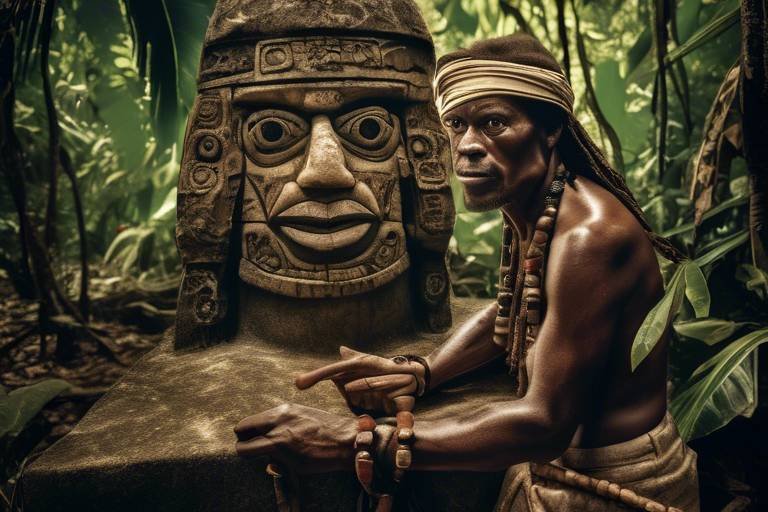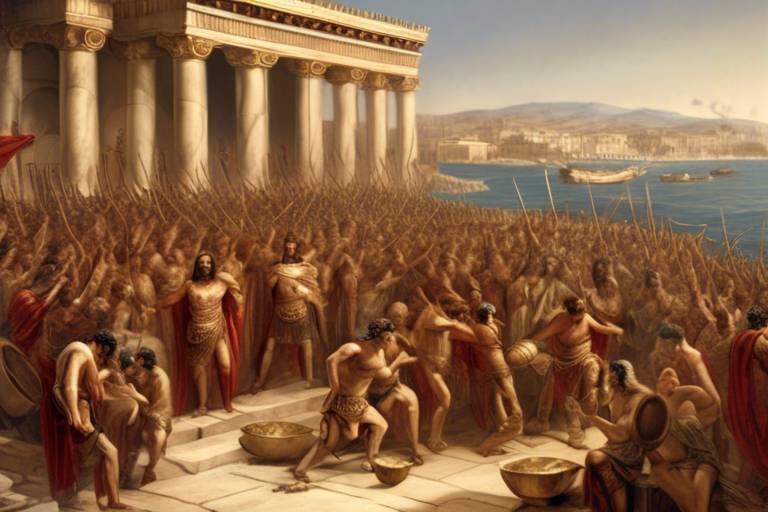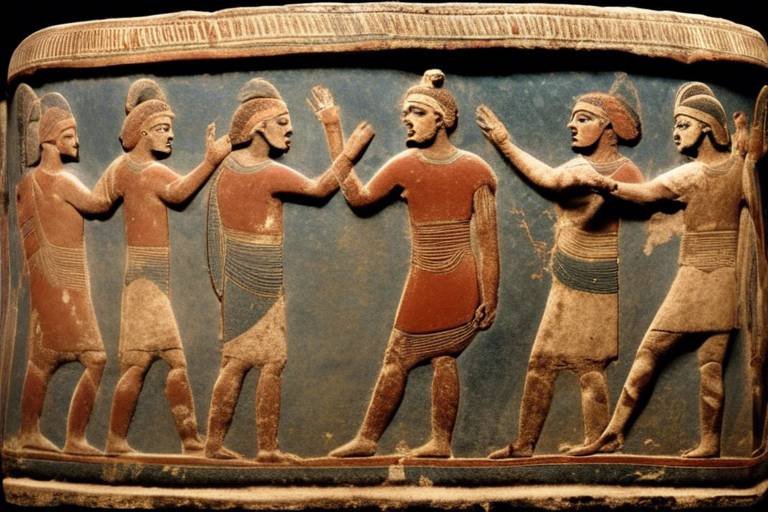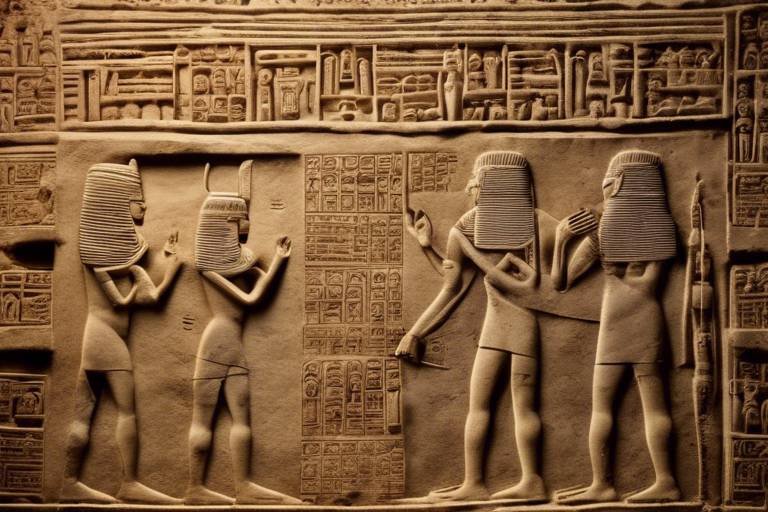The Cultural Exchange of Ancient Civilizations in Asia
Asia, the cradle of ancient civilizations, holds a treasure trove of cultural exchanges that have shaped the very essence of the region. From the bustling markets of the Silk Road to the serene temples of Southeast Asia, the interactions between civilizations have woven a rich tapestry of ideas, beliefs, and practices that continue to influence us today.
The Silk Road stands as a testament to the interconnectedness of ancient civilizations. This network of trade routes linked the East and the West, fostering not only the exchange of goods but also the sharing of knowledge and culture. Imagine the marvel of silk from China, spices from India, and ideas from Persia and Rome all converging along these ancient pathways.
Buddhism, with its profound teachings of compassion and enlightenment, transcended borders and spread its influence far and wide. Originating in India, this spiritual tradition found fertile ground in countries like China, Japan, Korea, and Southeast Asia, leaving an indelible mark on art, philosophy, and societal structures.
The Islamic civilizations of the Abbasid Caliphate and the Ottoman Empire made significant contributions to the artistic, scientific, and literary realms of Asia. Their architectural marvels, scientific discoveries, and literary masterpieces enriched the cultural landscape, fostering a diverse exchange of ideas and innovations.
In ancient Southeast Asia, the blending of Hindu and Buddhist beliefs gave rise to a unique syncretism that manifested in awe-inspiring temples like Angkor Wat. This harmonious fusion of spiritual practices is a testament to the peaceful coexistence and mutual influence of diverse cultures.
Confucianism, with its emphasis on ethics, morality, and social harmony, left an enduring legacy on East Asian societies. The teachings of Confucius permeated governance, education, and social norms in countries like China, Korea, Japan, and Vietnam, shaping the very fabric of their civilizations.
Maritime trade routes such as the Spice Route and the Indian Ocean trade played a pivotal role in connecting civilizations in South and Southeast Asia. The bustling ports and bustling markets facilitated the exchange of goods, ideas, and cultures, enriching the tapestry of diversity in the region.
Artistic exchanges across ancient Asian civilizations led to a vibrant fusion of styles, techniques, and motifs. Sculpture, painting, ceramics, and textiles bore the influences of various cultures, creating a visual feast that reflected the interconnectedness and creativity of the ancient world.
The legacy of these ancient interactions reverberates through the ages, shaping contemporary traditions, languages, religions, and societal values across Asia. The echoes of cultural exchange continue to resonate, reminding us of the beauty and complexity born from the mingling of civilizations.

Silk Road Connections
Exploring the rich history and interactions between ancient civilizations in Asia, highlighting the exchange of ideas, beliefs, and practices that shaped the cultural landscape of the region.
The Silk Road stands as a testament to the interconnectedness of ancient civilizations in Asia. This vast network of trade routes linked diverse lands such as China, India, Persia, and Rome, creating a bustling hub of commerce and cultural exchange. Imagine the vibrant markets filled with merchants from distant lands, trading silk, spices, precious metals, and exotic goods that sparked curiosity and wonder.
As caravans traversed the arid deserts and treacherous mountains, they not only transported goods but also carried with them ideas, technologies, and philosophies that transcended borders. The Silk Road was not merely a path for trade; it was a bridge that connected people from different cultures, fostering a melting pot of traditions and innovations.
Through this intricate web of routes, civilizations shared knowledge of astronomy, mathematics, and medicine. Chinese silk found its way to the markets of Rome, while Roman glassware made its journey to the courts of China. The exchange of goods and ideas along the Silk Road was a catalyst for cultural diffusion, shaping the identities of societies along its vast expanse.
Have questions about the cultural exchange of ancient civilizations in Asia? Check out some common queries below:
- What role did the Silk Road play in spreading religions across Asia?
- How did the Silk Road impact the development of art and architecture in ancient civilizations?
- What were some of the major goods traded along the Silk Road?
- How did the Silk Road contribute to the exchange of scientific knowledge?

Buddhist Influence
Buddhism, originating in ancient India, spread its profound influence across various Asian civilizations, leaving an indelible mark on art, philosophy, and social structures. The teachings of Siddhartha Gautama, the Buddha, resonated deeply with societies in China, Japan, Korea, and Southeast Asia, fostering a spiritual and cultural connection that transcended borders and languages.
As Buddhism traveled along trade routes like the Silk Road, it not only brought spiritual guidance but also facilitated the exchange of ideas and practices between diverse cultures. Monasteries became centers of learning and artistic expression, where monks and scholars translated texts, studied philosophy, and created intricate artworks that reflected the essence of Buddhist teachings.
The spread of Buddhism led to the construction of magnificent temples, stupas, and statues, each embodying the unique artistic styles and architectural designs of the regions where the religion took root. From the serene beauty of Zen gardens in Japan to the intricate carvings of Borobudur in Indonesia, Buddhist influence manifested in various forms, captivating the hearts and minds of believers and admirers alike.
Moreover, the ethical principles of Buddhism, such as compassion, mindfulness, and non-violence, permeated societal norms and governance structures, shaping a more harmonious and compassionate approach to interpersonal relationships and community welfare. The teachings of impermanence and interconnectedness resonated with people from different walks of life, fostering a sense of unity and empathy across diverse cultures.
Through the propagation of Buddhist scriptures, art, and rituals, ancient Asian civilizations embraced a shared spiritual heritage that transcended linguistic barriers and political boundaries. The fusion of local traditions with Buddhist practices gave rise to unique cultural expressions, blending the spiritual essence of Buddhism with the rich tapestry of indigenous beliefs and customs.

Islamic Contributions
Islamic civilizations have made significant contributions to the cultural landscape of Asia, leaving a lasting impact on art, science, architecture, and literature. The Abbasid Caliphate, known for its advancements in various fields, played a crucial role in fostering a diverse cultural exchange across the region. Through the translation of ancient texts and the preservation of knowledge, Islamic scholars contributed to the development of science and philosophy, influencing not only their own societies but also neighboring civilizations.
Architecture flourished under Islamic rule, with magnificent structures like the Taj Mahal in India and the Blue Mosque in Turkey standing as testaments to the intricate designs and grandeur of Islamic artistry. The blending of architectural styles from different regions created a unique fusion that continues to inspire awe and admiration to this day. Moreover, the intricate patterns and geometric designs found in Islamic art have influenced artists and designers across Asia, leaving a profound mark on the visual culture of the continent.
Islamic literature, particularly poetry and storytelling, has captivated audiences for centuries, with renowned works like the Rubaiyat of Omar Khayyam and the One Thousand and One Nights showcasing the richness and depth of Islamic storytelling traditions. These literary masterpieces not only entertained but also conveyed moral lessons and philosophical insights, shaping the intellectual landscape of the societies in which they were shared.
Scientific advancements made by Islamic scholars during the Golden Age of Islam paved the way for innovations in fields such as mathematics, astronomy, and medicine. The development of algebra, the refinement of astronomical instruments, and the establishment of hospitals and medical schools are just a few examples of the enduring contributions that Islamic civilizations have made to the world. These advancements not only benefited the societies in which they originated but also spread knowledge and expertise to other parts of Asia through cultural exchange.

Hindu-Buddhist Syncretism
When exploring the concept of Hindu-Buddhist syncretism in ancient Southeast Asia, we delve into a fascinating blend of two distinct belief systems that harmoniously coexisted and influenced each other. This cultural fusion is exemplified in the architectural marvels of the region, with a prime example being the awe-inspiring Angkor Wat in Cambodia. Here, Hindu and Buddhist elements seamlessly intertwine, showcasing the mutual respect and integration of diverse spiritual practices.
The syncretism between Hinduism and Buddhism goes beyond mere architectural structures; it permeates various aspects of art, philosophy, and societal norms in ancient Southeast Asian civilizations. The intricate carvings depicting Hindu deities alongside Buddhist motifs on temple walls reflect a deep intertwining of spiritual ideologies, symbolizing a shared cultural heritage.
Through this syncretic approach, ancient Southeast Asian societies were able to create a unique identity that embraced the essence of both Hinduism and Buddhism. This cultural exchange not only enriched artistic expressions but also fostered a sense of unity among diverse communities, transcending religious boundaries and promoting mutual understanding.
Furthermore, the syncretism of Hindu and Buddhist beliefs in Southeast Asia served as a testament to the openness and adaptability of ancient civilizations in embracing new ideas and perspectives. It demonstrates the fluid nature of cultural interactions, where traditions from different origins could blend harmoniously to create something entirely new and profound.

Confucian Traditions
Confucian Traditions in ancient Asia played a pivotal role in shaping the societal norms, values, and governance structures of East Asian civilizations. Originating from the teachings of Confucius in China, Confucianism emphasized the importance of filial piety, respect for elders, and moral integrity. Through cultural exchange, these core values spread to countries like Korea, Japan, and Vietnam, influencing their ethical frameworks and social hierarchies.
One of the key aspects of Confucian traditions was the emphasis on education and scholarship. The civil service examination system, based on Confucian principles, became a cornerstone of governance in many East Asian societies, promoting meritocracy and intellectual pursuits. This system not only shaped the political landscape but also fostered a culture of learning and intellectual development across the region.
Furthermore, Confucianism's emphasis on harmony and social order had a lasting impact on family dynamics and community relationships. The concept of the Five Relationships, outlining the proper conduct between individuals in various roles, guided interpersonal interactions and laid the foundation for a stable and cohesive society. This emphasis on social harmony through defined roles and responsibilities continues to influence East Asian cultures to this day.
Moreover, the enduring influence of Confucian traditions can be seen in the art, literature, and architecture of East Asian civilizations. From intricate calligraphy and poetry to grand temples and palaces, the aesthetics and cultural expressions of these societies were deeply intertwined with Confucian ideals of virtue, humility, and reverence for the past. This artistic fusion of philosophy and creativity exemplified the holistic nature of Confucian traditions in shaping every aspect of life.
In conclusion, the legacy of Confucianism in ancient Asia transcended borders and time, leaving a profound imprint on the cultural heritage of the region. Through cultural exchange and adaptation, Confucian traditions became embedded in the fabric of East Asian societies, influencing values, governance structures, and artistic expressions for centuries to come.

Trade Routes and Maritime Networks
Trade routes and maritime networks played a pivotal role in connecting ancient civilizations across Asia, fostering the exchange of goods, ideas, and cultures. The Spice Route, a network of land and sea routes linking the East and West, facilitated the trade of valuable spices, textiles, and precious metals between regions like India, Southeast Asia, China, and the Mediterranean. This vibrant exchange not only enriched economies but also led to the transmission of knowledge, technologies, and cultural practices.
Maritime trade routes, particularly the Indian Ocean trade, connected diverse societies along the coastlines of South and Southeast Asia, promoting interactions between civilizations such as the Indus Valley, Chola Empire, Srivijaya, and Majapahit. These networks enabled the transportation of commodities like silk, ceramics, spices, and gemstones, contributing to the prosperity and cultural diffusion among coastal communities.
The interconnectedness of trade routes and maritime networks not only facilitated commercial transactions but also served as conduits for the exchange of religious beliefs, artistic influences, and architectural styles. The blending of cultures along these routes gave rise to syncretic traditions, hybrid art forms, and cosmopolitan cities that thrived on the diversity brought by transnational interactions.

Artistic Exchanges
Artistic exchanges among ancient Asian civilizations were pivotal in shaping the vibrant cultural landscape of the region. Through the exchange of artistic styles, techniques, and motifs, civilizations like China, India, Persia, and Southeast Asia influenced each other, creating a rich tapestry of artistic expression. Sculpture, painting, ceramics, and textiles were mediums through which ideas and creativity traversed borders, transcending language barriers and reflecting the diverse cultural heritage of Asia.
The intricate patterns of Chinese ceramics found their way to Persia, inspiring new designs and techniques in pottery. Indian sculptures depicting mythological narratives influenced artistic traditions in Southeast Asia, blending with local styles to create unique masterpieces. Persian miniature paintings captivated the hearts of viewers in India, leading to the fusion of Persian and Indian artistic elements in Mughal art, showcasing a cross-cultural artistic exchange.
Furthermore, the Silk Road played a crucial role in the transmission of artistic ideas, as traders and travelers carried artworks and artifacts along the vast network of trade routes. Buddhist sculptures from Gandhara in present-day Pakistan traveled to China, influencing the development of Buddhist art in the region. The intricate carvings of Hindu temples in India inspired architectural marvels in Cambodia, where Hindu and Buddhist motifs converged in structures like Angkor Wat.
Artistic exchanges were not merely about the transfer of tangible objects but also about the exchange of intangible concepts and philosophies. The depiction of nature in Chinese landscape paintings resonated with Japanese artists, leading to the adaptation of Chinese painting techniques in Japanese art. The art of calligraphy, originating in China, spread to Korea and Japan, evolving into unique styles that reflected the cultural nuances of each region.
Through artistic exchanges, ancient Asian civilizations transcended geographical boundaries and temporal constraints, creating a legacy of creativity and innovation that continues to inspire contemporary artists and enthusiasts. The fusion of artistic traditions from diverse cultures laid the foundation for a shared artistic heritage that celebrates the beauty of cultural diversity and the power of creative expression.

Legacy of Ancient Interactions
Exploring the rich history and interactions between ancient civilizations in Asia, highlighting the exchange of ideas, beliefs, and practices that shaped the cultural landscape of the region.
As we delve into the legacy of ancient interactions among Asian civilizations, we uncover a tapestry woven with threads of cultural fusion and shared heritage. The exchanges that took place centuries ago continue to reverberate through time, leaving an indelible mark on contemporary traditions and societal values across Asia.
One of the most significant legacies of ancient interactions is the linguistic diversity that characterizes the region. Languages have evolved and intertwined, influenced by the cross-cultural exchanges of the past. From Sanskrit roots in Southeast Asian languages to the spread of Chinese characters across East Asia, the linguistic legacy of ancient civilizations remains palpable today.
Moreover, the religious landscape of Asia bears the imprints of ancient interactions, with syncretic beliefs and practices shaping spiritual traditions. The blending of Hindu, Buddhist, and Islamic influences has created a rich tapestry of faith that transcends borders and unites diverse communities in shared reverence.
Architectural marvels stand as enduring testaments to the cultural exchange of ancient civilizations. From the majestic temples of Angkor Wat to the intricate mosques of the Mughal Empire, these structures embody the synthesis of artistic styles and engineering prowess that defined the architectural landscape of Asia.
The legacy of ancient interactions also manifests in the culinary heritage of the region, where flavors and culinary techniques have mingled to create a gastronomic tapestry that tantalizes the taste buds. The spices of the Silk Road, the noodles of China, and the curries of India all bear witness to the cross-cultural culinary exchanges that have shaped Asian cuisine.
Through the legacy of ancient interactions, we are reminded of the interconnectedness of Asian civilizations and the enduring impact of cultural exchange on shaping identities and fostering mutual understanding. As we navigate the complexities of the modern world, the echoes of the past serve as guiding beacons, illuminating the path towards a more harmonious and inclusive future.
Frequently Asked Questions
- What were the main trade routes that facilitated cultural exchange in ancient Asia?
The main trade routes that facilitated cultural exchange in ancient Asia were the Silk Road, the Spice Route, and the Indian Ocean trade routes. These routes connected civilizations such as China, India, Persia, and Rome, allowing for the exchange of goods, technologies, and ideas.
- How did Buddhism influence the cultural landscape of ancient Asian civilizations?
Buddhism had a profound impact on ancient Asian civilizations by spreading from its origins in India to countries like China, Japan, Korea, and Southeast Asia. It influenced art, philosophy, social structures, and even political systems, leaving a lasting imprint on the region.
- What is Hindu-Buddhist syncretism and where can it be seen in ancient Southeast Asia?
Hindu-Buddhist syncretism refers to the blending of Hindu and Buddhist beliefs and practices. This cultural fusion can be seen in ancient Southeast Asia, particularly in architectural marvels like Angkor Wat in Cambodia, which reflects the harmonious coexistence and integration of both traditions.
- How did Confucianism influence East Asian societies through cultural exchange?
Confucianism had a significant influence on East Asian societies such as China, Korea, Japan, and Vietnam. Through cultural exchange, Confucian values shaped governance, social norms, and family structures, playing a pivotal role in shaping the cultural identity of these regions.
- What is the legacy of ancient interactions among Asian civilizations on contemporary traditions?
The legacy of ancient interactions among Asian civilizations is evident in contemporary traditions, languages, religions, and societal values across the region. These interactions have contributed to the rich cultural tapestry of Asia, shaping the diverse heritage that is celebrated and preserved to this day.



















